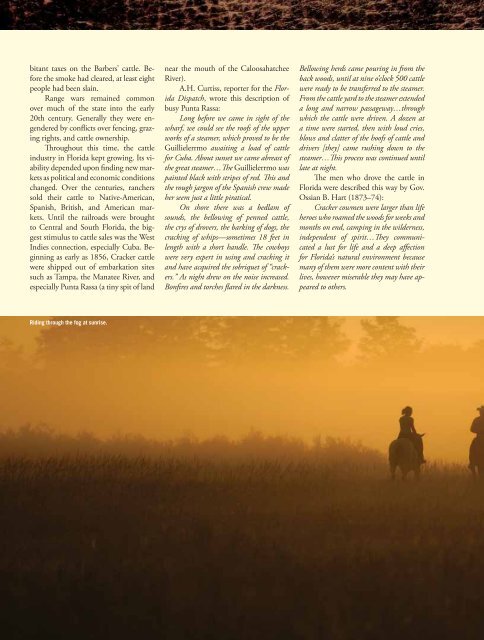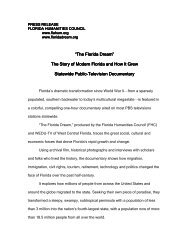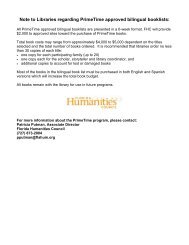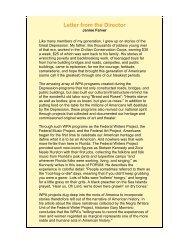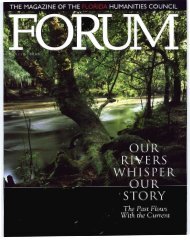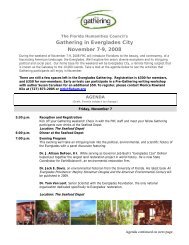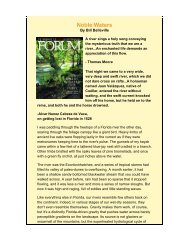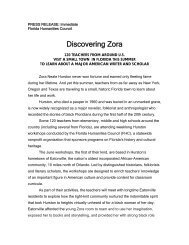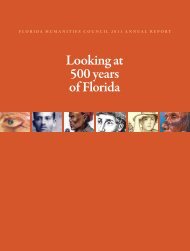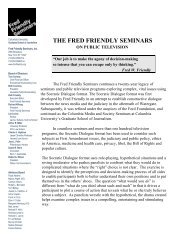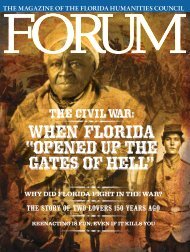THE MAGAZINE OF THE FLORIDA HUMANITIES COUNCIL
THE MAGAZINE OF THE FLORIDA HUMANITIES COUNCIL
THE MAGAZINE OF THE FLORIDA HUMANITIES COUNCIL
You also want an ePaper? Increase the reach of your titles
YUMPU automatically turns print PDFs into web optimized ePapers that Google loves.
itant taxes on the Barbers’ cattle. Before<br />
the smoke had cleared, at least eight<br />
people had been slain.<br />
Range wars remained common<br />
over much of the state into the early<br />
20th century. Generally they were engendered<br />
by conflicts over fencing, grazing<br />
rights, and cattle ownership.<br />
Throughout this time, the cattle<br />
industry in Florida kept growing. Its viability<br />
depended upon finding new markets<br />
as political and economic conditions<br />
changed. Over the centuries, ranchers<br />
sold their cattle to Native-American,<br />
Spanish, British, and American markets.<br />
Until the railroads were brought<br />
to Central and South Florida, the biggest<br />
stimulus to cattle sales was the West<br />
Indies connection, especially Cuba. Beginning<br />
as early as 1856, Cracker cattle<br />
were shipped out of embarkation sites<br />
such as Tampa, the Manatee River, and<br />
especially Punta Rassa (a tiny spit of land<br />
Riding through the fog at sunrise.<br />
near the mouth of the Caloosahatchee<br />
River).<br />
A.H. Curtiss, reporter for the Florida<br />
Dispatch, wrote this description of<br />
busy Punta Rassa:<br />
Long before we came in sight of the<br />
wharf, we could see the roofs of the upper<br />
works of a steamer, which proved to be the<br />
Guillielerrmo awaiting a load of cattle<br />
for Cuba. About sunset we came abreast of<br />
the great steamer…The Guillielerrmo was<br />
painted black with stripes of red. This and<br />
the rough jargon of the Spanish crew made<br />
her seem just a little piratical.<br />
On shore there was a bedlam of<br />
sounds, the bellowing of penned cattle,<br />
the crys of drovers, the barking of dogs, the<br />
cracking of whips—sometimes 18 feet in<br />
length with a short handle. The cowboys<br />
were very expert in using and cracking it<br />
and have acquired the sobriquet of “crackers.”<br />
As night drew on the noise increased.<br />
Bonfires and torches flared in the darkness.<br />
1 W I N T E R 2 0 0 6 / F O R U M F L O R I D A H U M A N I T I E S C O U N C I L<br />
Bellowing herds came pouring in from the<br />
back woods, until at nine o’clock 500 cattle<br />
were ready to be transferred to the steamer.<br />
From the cattle yard to the steamer extended<br />
a long and narrow passageway…through<br />
which the cattle were driven. A dozen at<br />
a time were started, then with loud cries,<br />
blows and clatter of the hoofs of cattle and<br />
drivers [they] came rushing down to the<br />
steamer…This process was continued until<br />
late at night.<br />
The men who drove the cattle in<br />
Florida were described this way by Gov.<br />
Ossian B. Hart (1873–74):<br />
Cracker cowmen were larger than life<br />
heroes who roamed the woods for weeks and<br />
months on end, camping in the wilderness,<br />
independent of spirit…They communicated<br />
a lust for life and a deep affection<br />
for Florida’s natural environment because<br />
many of them were more content with their<br />
lives, however miserable they may have appeared<br />
to others.


